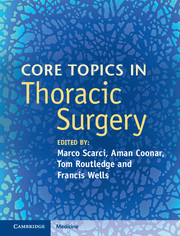18 results
Chapter 10 - Mitral Valve Surgery
- from Section 2 - Anaesthesia for Specific Procedures
-
-
- Book:
- Core Topics in Cardiac Anaesthesia
- Published online:
- 12 May 2020
- Print publication:
- 23 April 2020, pp 75-81
-
- Chapter
- Export citation
Section III - Benign conditions of the lung
-
- Book:
- Core Topics in Thoracic Surgery
- Published online:
- 05 September 2016
- Print publication:
- 08 December 2016, pp -
-
- Chapter
- Export citation
Section VIII - Other topics
-
- Book:
- Core Topics in Thoracic Surgery
- Published online:
- 05 September 2016
- Print publication:
- 08 December 2016, pp -
-
- Chapter
- Export citation
Section I - Diagnostic work-up of the thoracic surgery patient
-
- Book:
- Core Topics in Thoracic Surgery
- Published online:
- 05 September 2016
- Print publication:
- 08 December 2016, pp -
-
- Chapter
- Export citation
Section VI - Diseases of the chest wall and diaphragm
-
- Book:
- Core Topics in Thoracic Surgery
- Published online:
- 05 September 2016
- Print publication:
- 08 December 2016, pp -
-
- Chapter
- Export citation
Section IV - Malignant conditions of the lung
-
- Book:
- Core Topics in Thoracic Surgery
- Published online:
- 05 September 2016
- Print publication:
- 08 December 2016, pp -
-
- Chapter
- Export citation
Contents
-
- Book:
- Core Topics in Thoracic Surgery
- Published online:
- 05 September 2016
- Print publication:
- 08 December 2016, pp v-vi
-
- Chapter
- Export citation
Index
-
- Book:
- Core Topics in Thoracic Surgery
- Published online:
- 05 September 2016
- Print publication:
- 08 December 2016, pp 275-283
-
- Chapter
- Export citation
Section V - Diseases of the pleura
-
- Book:
- Core Topics in Thoracic Surgery
- Published online:
- 05 September 2016
- Print publication:
- 08 December 2016, pp -
-
- Chapter
- Export citation
Section VII - Disorders of the esophagus
-
- Book:
- Core Topics in Thoracic Surgery
- Published online:
- 05 September 2016
- Print publication:
- 08 December 2016, pp -
-
- Chapter
- Export citation
Frontmatter
-
- Book:
- Core Topics in Thoracic Surgery
- Published online:
- 05 September 2016
- Print publication:
- 08 December 2016, pp i-iv
-
- Chapter
- Export citation
Section II - Upper airway
-
- Book:
- Core Topics in Thoracic Surgery
- Published online:
- 05 September 2016
- Print publication:
- 08 December 2016, pp -
-
- Chapter
- Export citation
List of contributors
-
- Book:
- Core Topics in Thoracic Surgery
- Published online:
- 05 September 2016
- Print publication:
- 08 December 2016, pp vii-x
-
- Chapter
- Export citation

Core Topics in Thoracic Surgery
-
- Published online:
- 05 September 2016
- Print publication:
- 08 December 2016
Author Biographies
-
-
- Book:
- Pedagogy in Higher Education
- Published online:
- 05 November 2013
- Print publication:
- 18 November 2013, pp vii-xii
-
- Chapter
- Export citation
Contributors
-
-
- Book:
- Core Topics in Cardiac Anesthesia
- Published online:
- 05 April 2012
- Print publication:
- 15 March 2012, pp x-xiii
-
- Chapter
- Export citation
Chapter 32 - Mitral valve disease
- from Section 7 - Anesthetic management of specific conditions
-
-
- Book:
- Core Topics in Cardiac Anesthesia
- Published online:
- 05 April 2012
- Print publication:
- 15 March 2012, pp 200-207
-
- Chapter
- Export citation
Outcome of ligation of the persistently patent arterial duct in neonates as performed by an outreach surgical team
-
- Journal:
- Cardiology in the Young / Volume 17 / Issue 5 / October 2007
- Published online by Cambridge University Press:
- 01 October 2007, pp. 541-544
-
- Article
- Export citation

